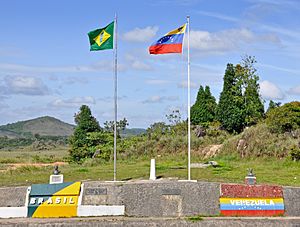Brazil–Venezuela border facts for kids
The Brazil–Venezuela border is the line that separates the countries of Brazil and Venezuela. This border was officially set by a treaty on May 5, 1859, and confirmed again in 1929.
The border starts at a special spot called a "triple point." This is where Brazil, Colombia, and Venezuela all meet at a place called Cucuy Rock. From there, the border follows a river channel and then a straight line to a mountain called Cerro Cupi.
After that, the border mostly follows the top of a drainage divide. Imagine a roof; rain falling on one side goes into one gutter, and rain on the other side goes into another. A drainage divide is like the peak of that roof for rivers. Here, it separates the rivers that flow into the Orinoco River (in Venezuela) from those that flow into the Amazon River (in Brazil).
This natural border continues all the way to another triple point on top of Mount Roraima, where Brazil, Guyana, and Venezuela meet. The total length of this border is about 2,199 kilometres (about 1,366 miles). Most of it (2,109 km) follows this natural watershed, while 90 km are straight lines agreed upon by the countries. The border passes through several mountain ranges in both Brazil (Amazonas state) and Venezuela (Roraima state), all part of the Guiana Shield.
Venezuela believes its border with Brazil is longer, about 2,850 km (1,770 miles). This is because Venezuela claims a part of western Guyana, called Guayana Esequiba. However, Brazil does not officially agree with this claim, and Guyana controls that area.
Most of the recognized border is in wild, hard-to-reach areas. There is only one main road crossing. This crossing is between the towns of Pacaraima in Brazil and Santa Elena de Uairén in Venezuela. Here, Brazil's BR-174 highway connects with Venezuela's Troncal 10 highway.
Contents
Recent events
People moving across the border
In 2018, Roraima, which is Brazil's northernmost state, saw many people from Venezuela moving across the border. This was part of a larger situation where many Venezuelans were leaving their country. On August 7, 2018, the government of Roraima asked Brazil's highest court to close the border. However, the court said no, explaining it was against Brazil's laws.
Border closures
On February 22, 2019, during a time of political trouble in Venezuela, President Nicolás Maduro closed the border. He did this to stop international aid, like food and medicine, from entering Venezuela by land. Later, in May 2019, the Venezuelan government announced that the border was open again.
During the COVID-19 pandemic
On March 16, 2020, Brazil's President Jair Bolsonaro partly closed the border with Venezuela. This was done to help slow down the spread of the COVID-19 pandemic. At that time, Brazil had 291 confirmed cases and its first death from the virus. Brazil's Health Minister had suggested closing the border because Venezuela's health system was struggling.
The next day, March 17, 2020, Venezuela's President Nicolas Maduro announced a country-wide quarantine. This happened after 16 new cases of the coronavirus were found, bringing Venezuela's total to 33 cases.
See also
 In Spanish: Frontera entre Brasil y Venezuela para niños
In Spanish: Frontera entre Brasil y Venezuela para niños



